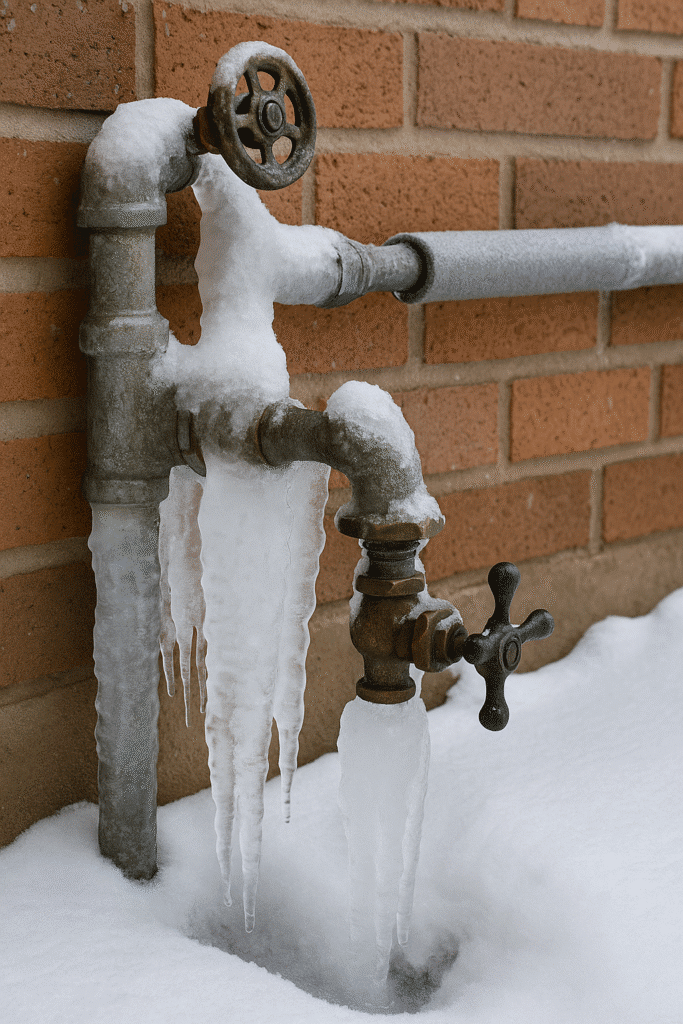Calgary Drain Cleaning | Winter in Calgary is not for the faint of heart. With average temperatures frequently dropping below -20°C, homeowners face a host of challenges. One of the most damaging (and costly) issues? Frozen pipes. Not only can frozen plumbing halt your water supply, but it can also lead to burst pipes, flooding, and extensive water damage.
Whether you’re a new homeowner or a seasoned Calgary resident, knowing how to prevent frozen pipes is essential. Let’s explore expert tips to keep your plumbing system safe and operational all winter long.
Why Pipes Freeze in Calgary Winters
Water expands as it freezes. When the water inside a pipe turns to ice, it creates pressure between the ice blockage and the closed faucet. Eventually, that pressure can cause the pipe to rupture. This is most common in:
- Exposed pipes in unheated areas (e.g., basements, crawl spaces, attics, garages).
- Outdoor hose bibs and sprinkler lines.
- Pipes running along exterior walls, especially in older homes with poor insulation.
Calgary’s fluctuating temperatures—from chinook warm-ups to deep cold snaps—make pipes especially vulnerable.
Tip 1: Insulate Pipes in Vulnerable Areas
Start by identifying pipes located in unheated or drafty areas. Use pipe insulation sleeves or heat tape to wrap these lines.
Focus on:
- Attics and crawl spaces.
- Pipes along exterior walls.
- Unfinished basements and garages.
You can find foam insulation tubes at most hardware stores, which are easy to install and budget-friendly.
Pro tip: Combine pipe insulation with wall insulation for double protection.
Tip 2: Keep the Heat On (Even If You’re Away)
If you’re leaving home for a winter vacation or extended trip, never turn the heat off completely. Even a couple of days without heating can be enough to freeze your pipes.
- Keep your thermostat at a minimum of 15°C (59°F).
- Ask a friend or neighbour to check in occasionally.
- Use smart thermostats for remote temperature control and alerts.
Tip 3: Seal Cracks and Gaps
Cold air can enter your home through gaps around windows, doors, pipes, and vents—especially where pipes pass through exterior walls.
Action steps:
- Use caulking or expanding foam to seal cracks and holes.
- Pay attention to openings in foundation walls and around cable or plumbing penetrations.
- Consider installing weather stripping on doors and windows.
These simple DIY fixes not only help prevent frozen pipes but also reduce your heating bills.
Tip 4: Let Faucets Drip During Extreme Cold
A small, steady drip from your faucets during a cold snap can prevent pressure from building up inside pipes. This keeps water moving, making it less likely to freeze.
- Focus on faucets served by exposed pipes.
- Open both hot and cold valves slightly.
- Use a bucket to collect the dripping water for plants or pets to avoid waste.
Tip 5: Open Cabinet Doors
Kitchen and bathroom sinks often have pipes located along exterior walls. These spaces can get much colder than the rest of your home, especially at night.
What to do:
- Open cabinet doors under sinks to allow warm air to circulate around the pipes.
- Remove any items that could block airflow (like cleaning supplies).
This tip is simple but incredibly effective in preventing localized pipe freezing.
Tip 6: Disconnect and Drain Outdoor Hoses
Before the deep cold sets in, make sure all garden hoses are disconnected and drained, and shut off water to outdoor taps if possible.
- Use the shut-off valve inside your home to drain exterior lines.
- Install frost-free hose bibs to reduce future risk.
Water left in a hose can freeze, expand, and cause pressure to back up into your plumbing system—damaging interior pipes in the process.
Tip 7: Invest in Smart Leak Detectors
Modern smart home technology can help you catch a pipe problem before it turns catastrophic.
Look for:
- Wi-Fi-enabled leak detectors with temperature sensors.
- Alerts sent directly to your phone.
- Integration with smart home systems like Google Home or Alexa.
These are especially helpful if you’re frequently away from home during the winter months.

Tip 8: Know Where Your Main Shut-Off Valve Is
If a pipe bursts, time is of the essence. Being able to shut off your water quickly can prevent thousands of dollars in damage.
- Locate your main shut-off valve (typically near where the water line enters your home).
- Make sure it’s accessible and functional.
- Show all family members where it is and how to use it.
What to Do If Your Pipes Freeze
Despite your best efforts, pipes may still freeze. Here’s how to handle it:
- Turn off the main water supply.
- Open the affected faucet to relieve pressure.
- Use gentle heat to thaw the pipe—hair dryers, heating pads, or space heaters work well.
- Never use an open flame, which can damage pipes or start a fire.
- Call a professional plumber if you can’t locate the frozen section or if a pipe has burst.
For emergency help, local experts like us are trained to quickly assess and repair winter-related plumbing issues.
Don’t Let Calgary’s Cold Catch You Off Guard
A frozen pipe can go from an inconvenience to a disaster in minutes. By following these proactive tips, you can save money, reduce stress, and keep your home safe and comfortable throughout the winter.
And remember, if you’re facing stubborn clogs or backups due to ice buildup, you may also need Calgary drain cleaning to restore flow and prevent further damage. Regular maintenance and a trusted plumber on speed dial can make all the difference.

